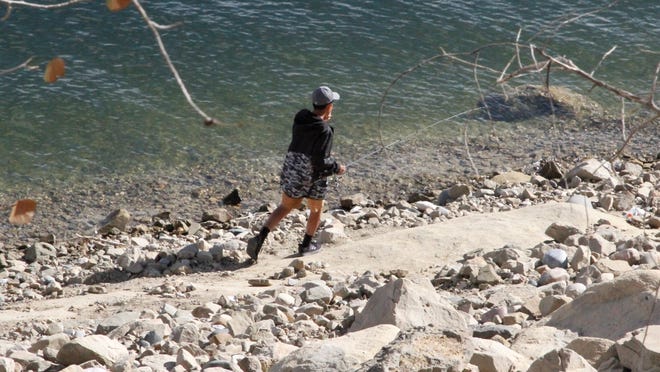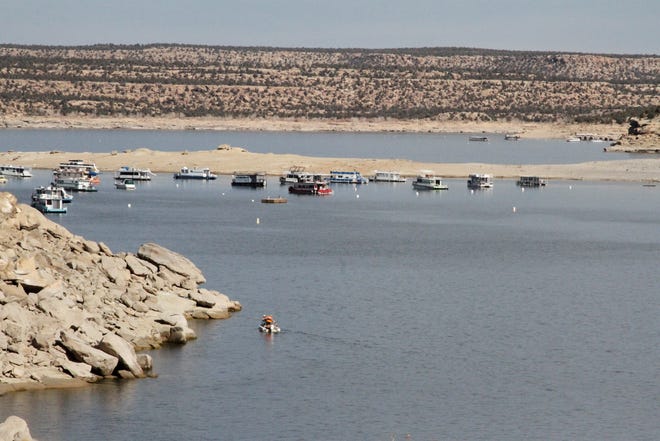Water lease agreement could help fish and help meet Colorado River Compact requirements

AZTEC — The New Mexico Interstate Stream Commission and The Nature Conservancy hope to demonstrate that the strategic water reserve can help endangered fish recover while also providing the ability to meet water compact requirements in the San Juan Basin.
The Interstate Stream Commission approved allowing ISC Director Rolf Schmidt-Petersen to continue negotiations with the Jicarilla Apache Nation to lease up to 20,000 acre feet of water annually that became available as it is no longer needed for operation of the San Juan Generating Station.
The Jicarilla Apache Nation acquired rights to water stored in Navajo Lake in 1992 and has the authority to lease this water to other entities to help the tribe. Up until recently, the nation has leased water to Public Service Company of New Mexico to operate the San Juan Generating Station.
But the potential of the power plant closing in 2022 as well as a reduction in the amount of water needed to operate it due to the closure of two units in 2016 means that this water is now available for the state to potentially lease.
Fishing report:Trout are biting on brown San Juan worms in the quality waters
Strategic water reserve could help fish, water compact requirements
The water would be placed in the strategic water reserve, which has two purposes: assisting with endangered species recovery and ensuring the state meets its obligations under water compacts. When needed, the water could be released from the reservoir to help with the fish or to meet the requirements of the 1922 Colorado River Compact.
The San Juan River is a tributary of the Colorado River and subject to the Colorado Water Compact, which requires a certain amount of water to reach Lake Powell.
The seven Colorado River basin states worked to develop drought contingency plans that were signed into law in 2019. A key component of the plan for the upper basin states, which includes New Mexico, is demand management. This involves storing water in designated reservoirs like Navajo Lake to release when needed to meet the compact requirements.

In addition, the San Juan River is home to two endangered fish species: the Colorado pikeminnow and the razorback sucker. Having additional water that can be released from Navajo Lake will help in efforts to improve habitat for those species, helping them recover and potentially be removed from the endangered species classification.
'Less and less water for everybody and that includes the fish'
"The reason we're looking at this now is because the Nation has some water available," said Dominque Work, an attorney for the Interstate Stream Commission. "Climate change means that there is less and less water for everybody and that includes the fish. And last but not least this is part of an effort to foster and promote and build on government to government relationships with tribal nations."
Terry Sullivan, the state director of The Nature Conservancy in New Mexico, said the organization has been working on the San Juan River for 15 years trying a variety of restoration projects to help create habitat. The fish rely on slow backwaters for reproduction.

"We've made some progress, we've learned a lot," he said.
But while The Nature Conservancy has worked to restore habitat, it has been limited in what it can do.
"One of the things that we've realized in the process of conducting these projects is that the missing element is extra water," he said.
Sullivan said the water lease is a great step forward to achieve both compact requirements and benefits to endangered species.
The amount leased each year would depend on funding available. One of the details of the lease agreement that has not yet been determined is the price.

Enchant Energy says Jicarilla Apache water is not needed for SJGS
Peter Mandelstam, the chief operating officer for Enchant Energy, said in a statement that the company believes it has enough water rights without the Jicarilla Apache lease to successfully retrofit the San Juan Generating Station with carbon capture technology and operate it.
“The City of Farmington and Enchant Energy have performed an extensive analysis to determine the water needs for San Juan Generating Station with carbon capture,” he said in the statement. “Based on the latest engineering design, we believe that we have sufficient water available under the existing permit (No. 2838) for the San Juan Generating Station. As part of our ongoing design work, we continue to have a dialogue with other water rights holders in the event that we determine that additional sources need to be acquired.”
Report:As climate change contributes to drought, closure of coal-fired power plants may help
Permit 2838 is ultimately held by BHP, the former owner of Navajo Mine, and is appropriated for use at both the San Juan Generating Station and the Four Corners Power Plant. This allows for the withdrawal of 51,600 acre feet annually, however only 39,000 acre feet can be used annually.
The remaining two units at San Juan Generating Station require approximately 12,000 acre-feet of water annually. That will increase to about 18,000 acre-feet if it is retrofitted with carbon capture technology.
Hannah Grover covers government for The Daily Times. She can be reached at 505-564-4652 or via email at hgrover@daily-times.com.